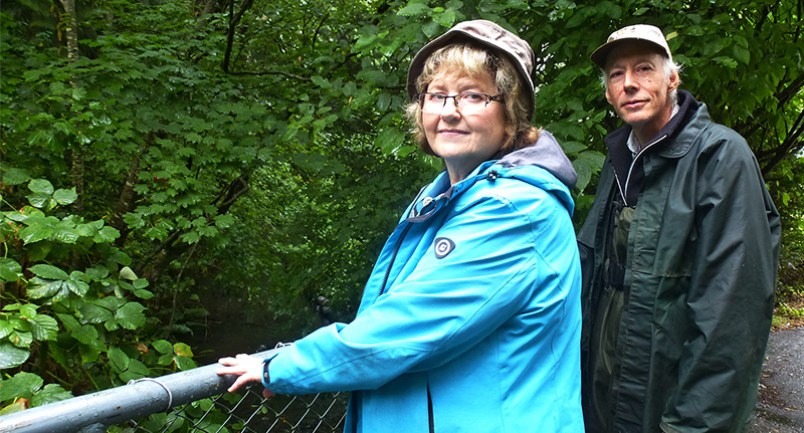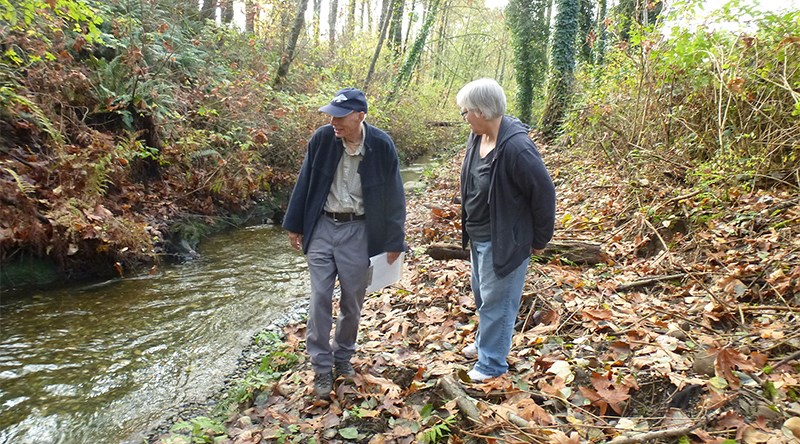A waterway that looks like a ditch flowing under Bedford Street in Port Coquitlam is alive with chum salmon. The fish splash noisily as they thrust their way out from a culvert to glide through a patch of deeper water under cover of blackberry brambles that have been chopped and left to rot.
It's messy but the salmon don't seem to mind as they thrash and glide along until they reach a stretch of open water behind a glass repair shop.
"I am absolutely thrilled and amazed," says Maple Creek Streamkeepers Society president Sandy Budd of the unusually large number of chum salmon that have shown up in the creek to spawn this fall. "Our iconic salmon, they're like the troopers of the world — it's amazing."
Is it a miracle that these chum salmon have made it back to the creek they were spawned in?
Budd, an 18-year member of the stream keeper group, says No. In part, she credits nature and the salmon's will to survive, but also the work of streamkeepers who have kept Maple Creek viable by doggedly working at improvements along the stretch of waterway that begins in a well near Ozada Avenue in Coquitlam.

Over the years, the group has spent a great deal of effort lobbying politicians to pay attention to creek-protection issues — this summer, in fact, they raised the alarm that a 10,000-sq. ft. house was being planned that would have required the creek to be relocated. That proposal hasn't officially come to Port Coquitlam council yet, and indications are that it will be scaled back, but when it does re-surface, Budd says, her group will be ready with petitions and lawn signs to make sure nothing is done to alter the course of the waterway.
"We are trying to improve the watershed and water quality, and clean up the mess that development has created in the watershed," Budd says, pulling no punches about what she believes has caused the drastic reduction in salmon in Tri-City creeks and streams in just a few generations.
Were it not for local hatcheries and streamkeeper groups that remind people to keep development from encroaching on streams and raise salmon from eggs to fry or smolts, the region would be devoid of salmon, she says. As it is, the salmon runs are a tenth of what they used to be when she was a girl growing up in PoCo.
Indeed, Maple Creek is the Rodney Dangerfield of salmon-bearing streams. Development in the Pipeline Road area harmed the headwaters years ago, requiring Coquitlam to install and maintain a pump to feed water into the creek. But the pump sometimes falters, as it did when it broke down this past summer, leaving fish stranded.
Along its 7-km stretch, Maple Creek flows through private property and behind businesses, and in some places looks like little more than a ditch because it has been channelized to accommodate development.
Budd gets furious when people describe Maple Creek as a ditch.
"Maple creek supports all seven species of wild salmon. Take a look, it's never just a ditch it's a channelized watercourse."
But Maple Creek has been disturbed in countless ways, recorded in stories published by The Tri-City News, and when the salmon do return home from up to three years spent in the ocean, they then have to run a gauntlet of culverts and a floodgate that closes when the creek runs too high.
This year, the salmon were greeted by a beautiful stretch of spawning grounds created by volunteers with the help of Lafarge Canada over several weeks this past summer. What looks like an underwater path of varying size of gravel is a nursery to the chum that travel in pairs up the creek from the Coquitlam and Fraser rivers.
"We just get a little excited," says Connie Boulos, who lives nearby on Jane Street and has been a member of the group for more than 17 years.
"That means they are getting over the barriers," she says, pointing to the fish darting about the river along the newly created spawning grounds.
You could say it's a miracle, and indeed it's surprising to see such a powerful example of nature's resilience, and one seen more and more along the Coquitlam River, Port Moody inlet and local creeks.
It's no miracle, but a community effort that has been more than 30 years in the making.



